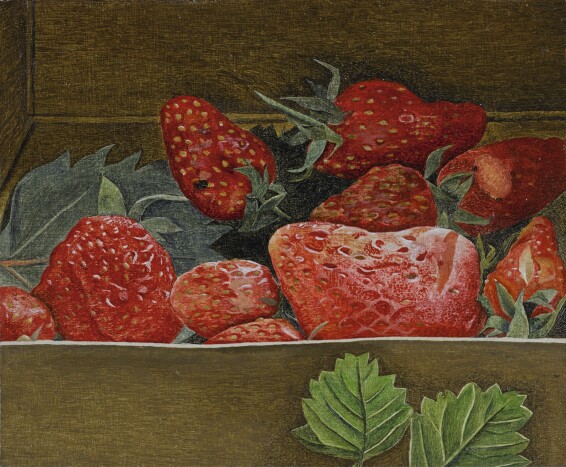- 7
Lucian Freud
Description
- Lucian Freud
- Strawberries
- oil on copper
- 10.2 by 12cm.
- 4 by 4 3/4 in.
- Painted circa 1950.
Provenance
Private Collection, United Kingdom (by descent from the above. Sold: Sotheby's, London, 23rd October 2001, lot 495)
Private Collection, Denver (purchased at the above sale)
Sale: Christie's, London, 8th February 2007, lot 55
Private Collection, United Kingdom (purchased at the above sale. Sold: Sotheby's, London, 17th October 2008, lot 36)
Hazlitt Holland-Hibbert, London
Purchased from the above by the present owner
Catalogue Note
Lawrence Gowing, Lucian Freud, London, 1982, p. 24
This jewel-like depiction of strawberries encapsulates the intensity of purpose, observation and technical virtuosity that has marked Freud as a master of his generation. Freud has transformed a simple still life into a work of extraordinary power and energy that extends far beyond the limits of the canvas. Throughout Freud's lifetime still lifes played an enduring and significant role, from as early as the 1940s they have laid the foundations to a discipline that is the principal artistic concern of his practice. Indeed, the extraordinary degree of psychological intensity and penetrating visual scrutiny that he places upon his human subjects owes a great debt to his still lifes.
Forensically observed down to its smallest naturalistic detail, the all-over composition of Strawberries is delicately articulated in modulating tones of succulent reds and verdant greens. Their stippled texture has been exceptionally rendered using the finest sable brushes, resulting in a quality that owes an immeasurable debt to the Netherlandish masters of the Northern Renaissance. As Freud explained: 'I felt that the only way I could work properly was using maximum observation and maximum concentration. I thought that by staring at my subject matter and by examining it closely I could get something from it [...]. I had a lot of eye trouble, terrible headaches because of the strain of painting so close' (L. Freud, quoted in Lucian Freud (exhibition catalogue), Museo Correr, Venice, 2005, p. 33).
Painted in 1950, the young Freud gifted this intimate work to Ann, Lady Rothermere. She was an early and passionate supporter of the painter, famously sitting for a portrait by him in the same year. Ann played a significant role in London's high society and delighted in gathering together political figures and aristocrats alongside writers and artists at her celebrated soirées. She introduced Freud to a wide circle of her influential friends, most notably the Devonshire family and a young girl who would quickly become his second wife, Lady Caroline Blackwood. Following a long affair she would later marry Ian Fleming and Freud would often visit them at their Jamaican villa Goldeneye, which they had acquired from Noel Coward.
Whether flesh, foliage or fabric, Freud's creative vision was fuelled by his obsessive commitment to conquering the intimate character of material and surface. From the very inception of his artistic practice plants and still lifes became significant protagonists in Freud's art, whether appearing as supporting actors, starkly contrasted against his uncompromising treatment of the human form, or as subjects in themselves. Devoid of humanity, these rare and intricate compositions reveal a glimpse of the artist at his most private and contemplative.

